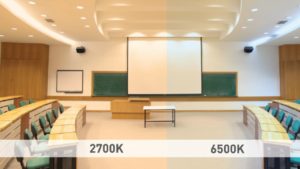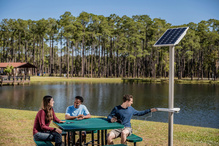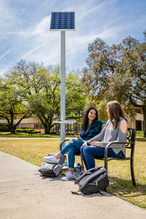College campuses come in all shapes and sizes and are often designed to provide all necessary amenities to students, professors and staff who spend their days there. But how often is that landscape thought of as a tool in the learning experience toolbox? Unless you attend school in a climate with limited seasonality or currently teach a field focused on nature, such as horticulture or biology, it is unlikely you’ve ever considered the impact of nature on students’ learning experiences. Humans naturally feel more comfortable in settings that exemplify or prominently feature other living things, open spaces, and natural beauty. In a study by the Heschong Mahone Group, students in daylit classrooms were shown to progress 21% faster than other students. How do you design a high-tech and modern campus or classroom that takes advantage of natural elements, like lighting, acoustics, natural patterns, plant life and more?
Start Simple with Windows
One way to bring students closer to nature is to increase their access to outdoor views by increasing the available window area during retrofits or new builds. We recommend considering larger operable windows, skylights, and bringing the facility’s most active spaces above ground. Instead of locating cafeterias or large lecture halls in basement levels, design these spaces for laboratories or theaters where natural light impedes the intended space use. Where extensions need to happen that are mainly underground, such as in libraries, leverage skylights or glass ceilings. In addition to bringing more natural light into new spaces, increasing window coverage improves the student experience while still meeting the desired campus aesthetic.
Move to Integrated Controls
Another option to bring more natural light into a space is to design integrated lighting and shading controls at the classroom and campus level. Shade systems consist of the shade itself, outfitted with a sensor and motor for automatic movement or with a pulley for manual operation. This system can be scheduled and managed through a room controller which can also control light levels, respond to occupancy, power on A/V systems, set scenes, and manage plug loads. Using a room controller to integrate these systems allows lighting levels and shade positions to quickly respond to specific classroom tasks like presentation mode, adjust natural light levels based on time of day and save energy by turning off when no class is scheduled.
Add in Some Color
 Whether you want to instill some school spirit or slowly ease early morning students into learning, using dynamic color or tunable white is a great way to design an interesting, engaging classroom. School colors such as blue and yellow can oscillate in lobbies or be used to highlight specific walls or features. Warm color temperatures, from 2700K to 3000K, have a warm glow that replicates incandescent light and can be used for morning and evening classes, simulating the natural cycle of the sun and moon. For mid-day classes, to mirror the sunlight outside, classroom lights can be tuned to from 3500K to 5000K which lends a blue-white hue. Intentional use of color can really enhance the learning experience on campus.
Whether you want to instill some school spirit or slowly ease early morning students into learning, using dynamic color or tunable white is a great way to design an interesting, engaging classroom. School colors such as blue and yellow can oscillate in lobbies or be used to highlight specific walls or features. Warm color temperatures, from 2700K to 3000K, have a warm glow that replicates incandescent light and can be used for morning and evening classes, simulating the natural cycle of the sun and moon. For mid-day classes, to mirror the sunlight outside, classroom lights can be tuned to from 3500K to 5000K which lends a blue-white hue. Intentional use of color can really enhance the learning experience on campus.
Take Class Outside
 The most enjoyable option for incorporating nature into learning is to bring class directly to nature, by hosting classes outside. Outdoor classrooms can be created on any campus. This goes beyond simply moving a class outdoors to intentionally establishing a defined outdoor learning space. To set up a functional classroom, permanent furniture, digital signage, power and charging capabilities are required. The first step is to find the ideal spot – one that doesn’t have too much direct sunlight but is not entirely shaded either. By ensuring the right location, bringing power to this space becomes much easier. Using solar power charging stations that install quickly into grass or pavement, instead of wiring an outdoor space, allows for flexible and sustainable design. Students benefit from still being connected while also enjoying the outdoors. Digital signage, such as an outdoor-rated flat panel mount with a pedestal column, can easily fit an interactive display for wayfinding around the campus, communication for updates on closures, events, schedules and more. Additionally, installing outdoor ground boxes and power pedestals can add to the functionality of the space by bringing in additional learning equipment.
The most enjoyable option for incorporating nature into learning is to bring class directly to nature, by hosting classes outside. Outdoor classrooms can be created on any campus. This goes beyond simply moving a class outdoors to intentionally establishing a defined outdoor learning space. To set up a functional classroom, permanent furniture, digital signage, power and charging capabilities are required. The first step is to find the ideal spot – one that doesn’t have too much direct sunlight but is not entirely shaded either. By ensuring the right location, bringing power to this space becomes much easier. Using solar power charging stations that install quickly into grass or pavement, instead of wiring an outdoor space, allows for flexible and sustainable design. Students benefit from still being connected while also enjoying the outdoors. Digital signage, such as an outdoor-rated flat panel mount with a pedestal column, can easily fit an interactive display for wayfinding around the campus, communication for updates on closures, events, schedules and more. Additionally, installing outdoor ground boxes and power pedestals can add to the functionality of the space by bringing in additional learning equipment.
Digitize Nature
 Now in a world where many of our interactions are digital or virtual, we need to consider how to still receive the benefits of nature when it is challenging to do so. We must recognize there are some scenarios where connecting directly with living things outside the human element is very difficult or not possible and identify unique solutions. Is your university or school located in the center of an urban area? Do you have a very short summer season? Are you located at a high altitude where the chilly days outnumber the warm? No matter the intricacies, it is possible to incorporate nature indoors through water features, digital imaging, and furniture and finishes. You are likely familiar with indoor water features and furniture but may be asking, how does one digitize nature? Recently on the Accenture corporate campus, the facility decided to install a multi-story digital sign that featured beautiful photographs of nature. This is one out-of-the-box way to overcome constraints.
Now in a world where many of our interactions are digital or virtual, we need to consider how to still receive the benefits of nature when it is challenging to do so. We must recognize there are some scenarios where connecting directly with living things outside the human element is very difficult or not possible and identify unique solutions. Is your university or school located in the center of an urban area? Do you have a very short summer season? Are you located at a high altitude where the chilly days outnumber the warm? No matter the intricacies, it is possible to incorporate nature indoors through water features, digital imaging, and furniture and finishes. You are likely familiar with indoor water features and furniture but may be asking, how does one digitize nature? Recently on the Accenture corporate campus, the facility decided to install a multi-story digital sign that featured beautiful photographs of nature. This is one out-of-the-box way to overcome constraints.
Conclusion
Design trends evolve and grow with market changes and in this time of COVID-19, that continues to be true. We know that fresh air, sunlight, and other elements of nature are good for the human body and mind. The above-highlighted design suggestions can evolve students’ learning experiences by bringing the outdoors in and the indoor out.
About the Author
Shana Longo has nine years of corporate sustainability and government affairs experience. She is currently the Sales Enablement Marketing Manager for Legrand’s Building Control System division focused on lighting controls in the healthcare, education and commercial office vertical.